 Temples of Himachal
 View from Naggar
Castle
Naggar was the ancient capital of the kings of Kullu for about 1,400 years.We were booked to stay at the Himachal Tourist Bugalow which was situated in the castle and was simply known as “The Castle.” It is situated on the left bank of the Beas river. We climbed up a windy road and at last reached the castle which was perched on top of a crag overlooking the village. The best view of the castle was actually from the road as we climbed but even the views from the other side were spectacular. Since it was a protected monument only those who had booked could go in. Others had to pay a small fee and could enter only at certain times. We walked down the cobbled courtyard and were shown to our rooms. Arvind and Chela had a huge room which could have happily accommodated at least 15 people with a tapestry bed and carpets etc. Unfortunately it was facing north and was as cold as a morgue. My room luckily faced east and was as cozy as a room with 15 foot high walls could be. I had hardly settled in when my companions followed me and took the identical room next door which was much warmer. Just outside was a wooden balcony with railings which overlooked the magnificent snow mountains. They were so close that I felt that if I leaned over the railings and stretched out my hands I could touch the peaks. Tearing my gaze away from the peaks I noticed that we could also see the river meandering its way across the valley and the villages which dotted the opposite banks. Altogether it was an incredible view. The rays of the setting sun were tingeing the peaks with red and then gold and then pink. We sat on the benches and watched while the last rays of the setting sun faded reluctantly from the peaks and the beautiful twilight set in. This place was the coldest that we had been in so far and the open air restaurant got uncomfortably cold while we had our typical Himachal dinner. The restaurant had a fantastic tree in the middle of the cobbled courtyard which shaded us from the morning sun when we went for breakfast the next morning.  Naggar Castle
There was a very interesting temple
right in the castle itself which was open only in the mornings. So this
was our first port of call. It was known as Jagatti Patt. When the
pujari opened the door we were surprised to find a huge block of stone
in the place of an idol. The stone was about a foot high and filled
almost the whole of the room. The stone was known as Dram Dhog
and it had a very interesting legend connected with it. In ancient days
one of the kings had married a princess from a far off land. She was
very homesick and longed to have something from her own land. She
prayed to the gods who took pity on her and took the form of a swarm of
bees and carried this huge rock all the way from her land and placed it
here. They settled on this rock and to this day, the rock is worshipped
as being divine. No doubt the princess was also very happy.
 Jagatti Patt Temple  A 5'x 8'x 6"
block of Brigu Tung hill known as "Dram
Dhog"
is worshiped at Jagatti Patt Temple in the Naggar Castle. The village devis & devtas in the form of a swarm of bees miraculously carried Dram Dhog 16 miles from Bahang Village to the castle, to comfort the young, home-sick Rani of Naggar.  Krishna
Temple, Naggar
Our actual destination was
the Krishna temple which we had heard about. High above the village set
amidst the Devataru (Deodar) trees was a Krishna temple which we
reached after quite a strenuous climb. There was actually a short route
which we missed and climbed up the way which was being made for cars.
There was a big wall round the temple and a door which led into the
cobbled courtyard. The temple was right in front of us set like a jewel
with the woods surrounding it and snow peaks in the distance. It was an
ancient 12th century temple made of stone and wood and had no
particular sculptures to make it outstanding but somehow it had an aura
of tranquility brought about I felt by the lack of pilgrims. As I went
through the door I felt that I had stepped into the past. The priest
was sitting outside in the sun reading the scriptures and did not even
look up as we arrived. I was most impressed by this and felt that he
was really a noble soul who did his work for love and not for money
unlike most temple priests.
I went inside and sat in the cold room adjoining the sanctum. Inside was a delightful idol of Muralidhara (Krishna with a flute). I sat and meditated for a long while my friends chatted with the priest’s son who spoke English. At last the priest finished his morning reading and came inside. By this time a flock of young college girls had arrived all giggling and chattering so he did an arati (waving of lights) and gave them some prasad. Then he went outside and sat down in the sun to do the yajna (fire ceremony). We were all set to leave but he beckoned us to sit and participate in the ritual. A hole had been made in the granite floor and this is where he did the fire ceremony by lighting some twigs and cow dung cakes. The fire burnt merrily and into this he poured ghee and other offerings. At last he finished and gave us all the nuts and dry fruits which we had brought as gifts. He courteously asked us to stay for lunch but we knew that it would be difficult to feed an extra three mouths so we refused. However we had an interesting chat with the son who had been abroad but preferred to return to his own home tucked away in this secluded forest instead of staying on in a modern town. He kept in touch with some of his friends by e mail and was successfully running a co-operative to help the farmers with their cultivation. Himachal was famous for its quality apples and many types of nuts. We would really have loved to stay on a little longer but we had to go on to our next destination which was the Roerich art gallery. This time we took the short cut back to the road.  Nicholas Roerich Home and Gallery The Roerich Art gallery is
only a few kilometers from the Castle. It was the originally the
residence of Nicholas K. Roerich and his beautiful wife Devika Rani who
had been a famous movie actress. He was a Russian nobleman who had
settled in Himachal Pradesh after the 1927 revolution. He was a great
artist and his dream was to unite the world through art. One of the
things on show was the 1930 Dodge car of the artist who must have loved
this place since he lived here for many years. The museum and art
gallery was a whitewashed building placed in the middle of a beautiful
garden in which there were many lovely sculptures. In fact we were
struck by the beautiful statues which were just outside the gate, under
a tree. The museum contained many of his paintings as well as those of
his son and other Russian artists.
Just about 100 metres climb from the museum was the Uruswati Himalayan Folk Arti Museum which has a collection of local folk art as well as Russian folk art. Roerich and his wife set it up in 1928. The word “Uruswati” is a Sanskrit word meaning “Light of the Morning Star”, and it was made with the intention to provide a place for study and research on the traditional and Tibetan medicines and the ethos of this Himalayan region. The museum has many Russian musical instruments, painted dolls and dishes and oil paintings by Russian artists. There are stone carvings from Ladakh, Kullu, idols of gods and goddesses and a photograph of Buddha. As went through the gardens I was wafted to another age and could almost see the dignified, gray bearded man walking arm in arm through that beautiful garden with his attractive wife who had been a legend in her time.  Kali Temple, Naggar  Shankar Temple Naggar  Tripura Sundari Temple, Naggar MANALI
The next day we set out for
Manali. En route we went to the ancient temple of Gayatri Devi in a
tiny village called Jagat Sukh. Surrounding this exquisite temple was a
number of ancient 12th century temples dedicated to Shiva, Parvati and
Ganesha. The Gayatri temple was well kept and had a priest attached to
it but the other temples seemed to be taken for granted the villagers
as part of their landscape and scant attention was paid to them. There
was a school down below and children ran about screaming, totally
disregarding these poems in stone. I was sad and felt that only in
India would such ancient monuments be considered as commonplace.
Perhaps this was one of the charms of India – the past crept into the
present and walked hand in hand with it.
 Gayatri Temple,
Jagat Sukh
 Gauri-Shankar Temple, Jagat Sukh The next temple to be visited was the Hidimbi Devi temple set amongst picturesque cedar woods. It was a striking temple and our first sight was of a 24 metres tall Shikkhar or spire above the sanctum. This consisted of three square roofs covered with timber tiles. It was capped with a golden cone. The base was made of whitewashed, mud-covered stonework. The temple had intricately carved wooden doors with beautiful carvings of Durga. The temple is actually made out of a huge jutting rock. Inside there is another huge rock with a tiny figure 3” high of the goddess. A rope hangs over the rock and according to legend, sinners would be tied by their hands on this rope and swung against the rock. Now of course the rope made it easier for us to descend to the hollow in which the figure was kept and climb up again.  Hidimbi was actually a rakshasi or demoness who had lived in these forests along with her brother Hidimba who had terrorized the sages who had built ashramas in this forest. The Pandavas who are the heroes of the Mahabharata had also lived in exile in this forest after their cousins had tried to burn them in a palace which had been specially designed with inflammable material. Bhima was the second one of the Pandavas and he was the strong man amongst them. Once the rishis had begged him to save them from the atrocities of Hidimba who was terrorizing them and even eating them alive whenever he managed to catch them. Bhima killed the rakshasa but fell for the charms of his sister Hidimbi and married her. Why she was deified is a mystery. Her only claim to glory was her son Gatotkacha who was a mighty figure with incredible strength and he had helped the Pandavas to win the war. In fact he gave his own life to save his uncle Arjuna. The moment we came out of the temple we were beset with ladies carrying Angora rabbits and men with yaks. One of them offered her rabbit to me and I gratefully took it and draped it over my shoulder. Immediately there was a flash and someone took a photograph and the woman started to pester me for money! I had taken it only because I thought it was an offering of love never realizing that there was a mercenary reason! Arvind and Chela were badgered into having their photos taken, sitting on one of the poor sad-looking yaks. We returned back to Naggar by evening all set for our next days adventure to Dharmshala. 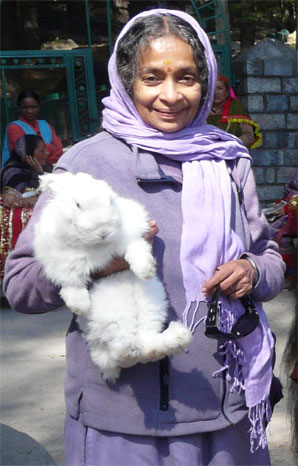 BAIJNATH
Baijnath temple was en route to
Dharmashala so that was our next stop. Actually this word is a
corruption of the word Vaidyanatha which means Lord of Physicians which
is another name for Lord Shiva. Legend has it that this is the place
where Ravana the demon king of Lanka worshipped Lord Shiva and
sacrificed all his ten heads in the fire. Because of this Dussera is
not celebrated here. That was the day on which Lord Rama killed Ravana
and it is believed that Shiva would get angry if that festival was
celebrated. In fact when it was celebrated a couple of times the men
who were responsible for conducting it died violent deaths and this was
accrued to being the wrath of Shiva.
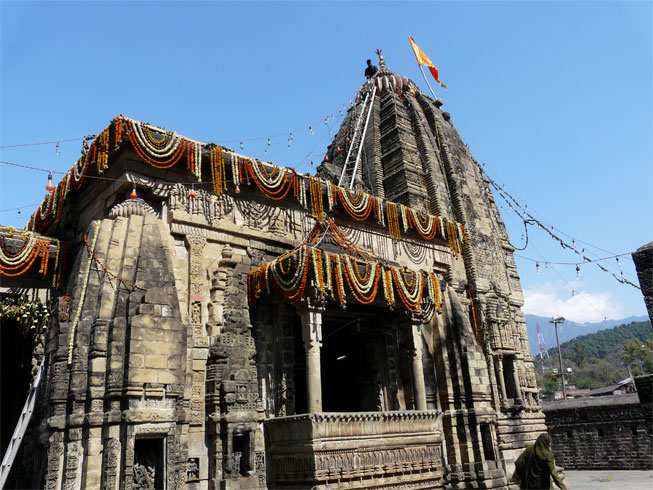 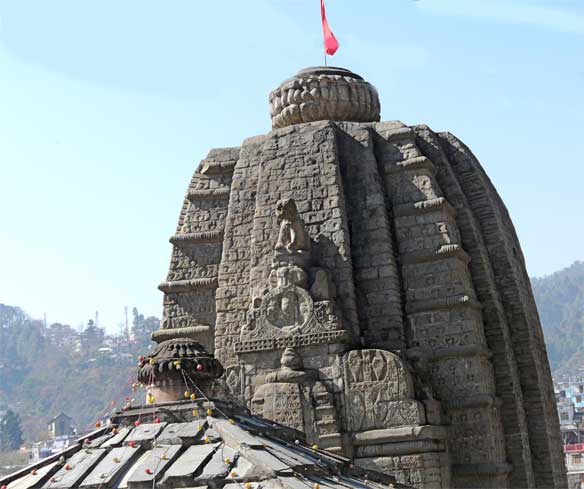 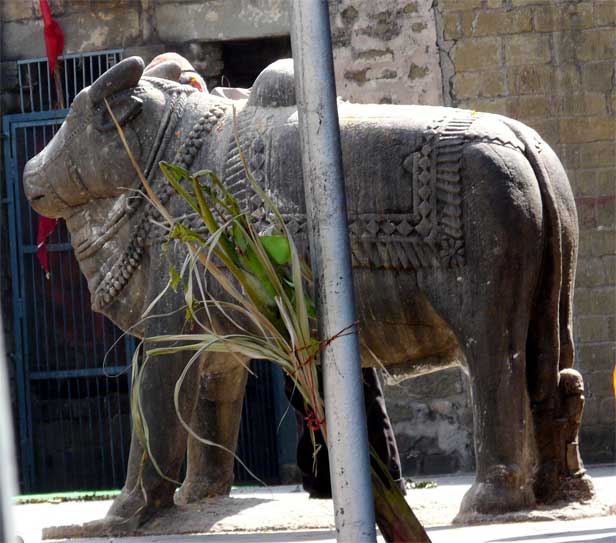 There is a beautiful Nandi outside in front of the sanctum. One of the strange features of the Himachal Nandis is the fact that they all have a human being wrapped in their tails. This one was no exception. We really felt as if we had got a bonus of health after going to this place. |
 Chamunda Devi Another ancient shrine en route to Dharmshala was the famous Shakti Peeth of Chamunda Devi. Chamunda is the fearful form of Durga and the idol is said to be so powerful that no one can gaze at it with the naked eye. Hence it is always covered with a red cloth. Shiva is also said to be present here in his form as Mahakala or the Lord of Death. Lord Shiva is said to have enshrined Parvati at this place in her fearful form after he killed the demon Jalandara and hence this site is also known as Rudra Chamunda. In ancient times, animal and perhaps human sacrifices used to be offered at this spot. The temple is supposed to be about 700 years old and has a big complex attached to it with a tank which is known as the Ban Ganga. Many people take a dip in the holy waters of this lake. There is also a cave at the back with a Shiva lingam. 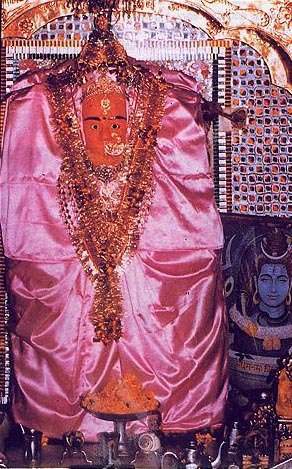 Chamunda Devi The legend of how the goddess got this particular name is given in the Devi Mahatmya. The goddess Parvati had taken on the form of Ambika in order to help the gods to defeat the terrible demons known as Shumbha and Nishumbha. Once when she was sitting on a mountain peak, these two demons who had heard of her beauty sent their minions known as Chanda and Munda to go and solicit her hand in marriage. She sweetly refused the offer and told them to tell their masters that she had taken a vow that she would marry only the one who could defeat her in battle. Shumba and Nishumbha sent their armies to defeat her but they were in turn defeated. During the battle Chanda and Munda were causing havoc to Ambika’s armies so she frowned and out of her frown came the wrathful form of Kaali. She told her to go and kill the two demons. Kaali did as ordered and returned carrying the heads of the two demons – Chanda and Munda. Ambika laughingly told her that from that day onwards she would be known as Chamunda (Chanda and Munda). As we entered the huge portals of the temple I felt very strong vibrations. We went and sat in front of the goddess for some time. Unfortunately we could not stay long since we still had a long way to go to our destination. It was indeed Her grace that we had been allowed at least this much of time with Her since this temple had not been included in our original itinerary. As we were traveling along the road to Dharmshala, we had been powerfully led to this place by the signpost showing the way to Chamunda Devi. Dharmshala
Shades of night were falling as eventually we made our way to Dharmshala. It is perched high on the slopes of the Himalayas against the backdrop of the Dhauladhar mountains. It is divided into two distinct sections – upper and lower with a difference of almost thousand meters in height. The upper section is known as Macleod Ganj and was originally reserved for the British as a refuge from the blistering heat of a Delhi summer. Now it is almost totally occupied by the Tibetans who had been displaced from their country and had to flee to India. The Indian government gave this to them and many of them have settled here and live a happy and peaceful life. It is also the place where the Dalai Lama resides. 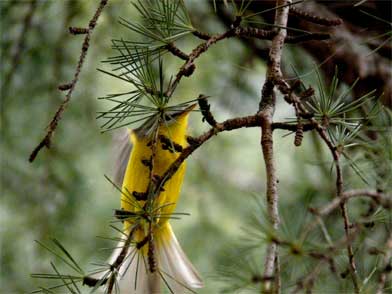  Chonor House  PadmaSambhava Rimpoche  Outside many young men were lying on the ground, on a fast since the little boy who had been chosen by the Dalai Lama to be his successor had been forcibly taken away from his parents and teachers and incarcerated in a room in which he was being indoctrinated with Chinese propaganda instead of Tibetan scriptures! The world was well aware of what was going on since on that day Tibetans all over the world were undertaking a fast and begging the United States to step in and save the little boy. But so far no one seemed to be doing anything to save him and soon it would be too late. Next we went to the market. Here of course we were really happy to see that the second generation of Tibetans led happy, healthy and quite affluent lives. They had little curio shops and restaurants and way-side stalls which did very good business since a stroll through this market place was a must for all those who came to Dharmshala. In fact you could almost believe that you were in some town in Tibet except that probably the Tibetan towns were not as prosperous looking. We found a purely Tibetan vegetarian restaurant run by monks which gave excellent food. Since vegetarian food is a rarity in Tibetan restaurants we were very happy to have found this one.  Dalai Lama Kullu Airport Jwalamukhi
My road on the other hand took me to the famous temple of Jwalamukhi which I had visited many years ago. It is fifty-six km. from Dharmshala. Jwalamukhi is one of the Shakti peethas and this is the place where Sati’s mouth fell (refer to the article on Sati for this story.) Thus she is known as the goddess of the flaming mouth since fire comes out of it. One of the ancient kings of Kangra, who was a great devotee of Durga, had a dream in which the goddess appeared to him and gave him directions to find this spot. He found the place and constructed a temple there. However the present temple was completed only in the 19th century by Maharaja Ranjit Singh and his son Kharak Singh who also gave gold and silver to construct the dome and door. This temple was built on a very simple wooden platform and the architecture is said to be Indo-Sikh. The dome and spire were plated with gold given by the king and the main door was made of silver. The huge bronze bell in front of the temple was presented by the King of Nepal.  Jwalamukhi Temple The actual spot where the flames appear is no more than a small circle of about three feet in circumference. A short flight of steps leads to the grotto in which you see two small pools of crystal clear water, fed by natural springs. Three orange jets of flame flare steadily from the sides of the pool, just a few inches above the surface of the water which looks as if it is bubbling. However if you put your hands into it, it is refreshingly cool. The temple has no idol since the goddess manifests herself in her nine forms as nine eternal flames. These are Mahakaali, Annapurna, Chandi, Hinglai, Vindhya Vasini, Mahalakshmi, Saraswati, Ambika and Anjini Devi. The offerings to the goddess are made into this pit in which the flames are perpetually burning. The temple is guarded by the fierce looking followers of the great Tantric, Goraknath, who had many miraculous powers. Sometimes the priest throws some water into the pit and immediately a huge flame comes out which invariably makes the devotees gasp. To date no one has been able to unravel the mystery behind these flames which might be due to a natural jet of combustible gas. Indians are famous for their ability to see God in anything especially in that which is strange and miraculous and thus to this day we see the power of the goddess manifesting itself through these incredible flames. Many tantrics and seekers have been drawn to this place through the ages and many are said to have attained siddhis or supernormal powers by the grace of the goddess as did the great sage, Goraknath. 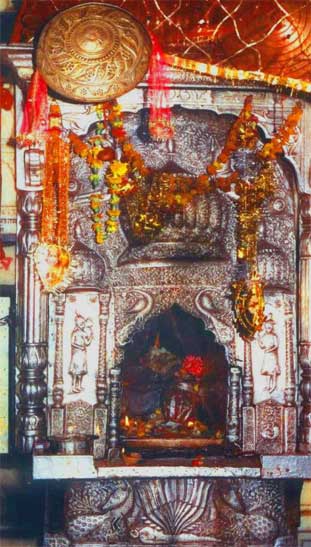 This was the last of our temples and I returned late at night to Rishikesh to the sanctuary of the Vanamali Ashram, saturated with the miracles of our Holy Land of Bharat. Hari Aum Tat Sat
|